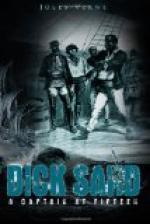Now Captain Hull, obliged to choose strong seamen to man the whale-boat, was forced to put on Dick Sand the care of guarding the “Pilgrim.”
“Dick,” said he to him, “I shall charge you to remain on board during my absence, which I hope will be short.”
“Well, sir,” replied the young novice.
Dick Sand would have wished to take part in this fishing, which had a great attraction for him, but he understood that, for one reason, a man’s arms were worth more than his for service in a whale-boat, and that for another, he alone could replace Captain Hull. So he was satisfied. The whale-boat’s crew must be composed of the five men, including the master, Howik, which formed the whole crew of the “Pilgrim.” The four sailors were going to take their places at the oars, and Howik would hold the stern oar, which serves to guide a boat of this kind. A simple rudder, in fact, would not have a prompt enough action, and in case the side oars should be disabled, the stern oar, well handled, could put the whale-boat beyond the reach of the monster’s blows.
There was only Captain Hull besides. He had reserved to himself the post of harpooner, and, as he had said, this would not be his first attempt. It was he who must first throw the harpoon, then watch the unrolling of the long line fastened at its end; then, finally finish the animal with spears, when it should return to the surface of the ocean.
Whalers sometimes employ firearms for this kind of fishing. By means of a special instrument, a sort of small cannon, stationed either on board the ship or at the front of the boat, they throw either a harpoon, which draws with it the rope fastened to its end, or explosive balls, which produce great ravages in the body of the animal.
But the “Pilgrim” was not furnished with apparatus of this kind. This was, besides, an instrument of high price, rather difficult to manage, and fishermen, but little friendly to innovations, seem to prefer the employment of primitive weapons, which they use skilfully—that is to say,—the harpoon and spear.
It was then by the usual method, attacking the whale with the sword, that Captain Hull was going to attempt to capture the jubarte signaled five miles from his ship.
Besides, the weather would favor this expedition. The sea, being very calm, was propitious for the working of a whale-boat. The wind was going down, and the “Pilgrim” would only drift in an insensible manner while her crew were occupied in the offing.
So the starboard whale-boat was immediately lowered, and the four sailors went into it.
Howik passed them two of those long spears which serve as harpoons, then two long lances with sharp points. To those offensive arms he added five coils of those strong flexible ropes that the whalers call “lines,” and which measure six hundred feet in length. Less would not do, for it sometimes happens that these cords, fastened end to end, are not enough for the “demand,” the whale plunges down so deep.




